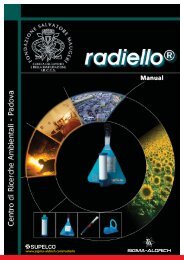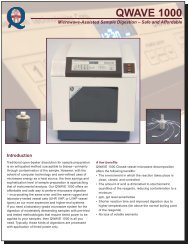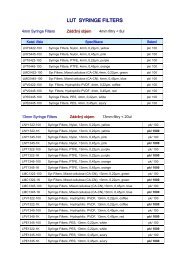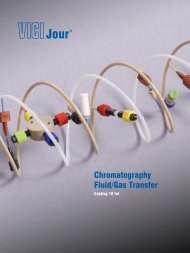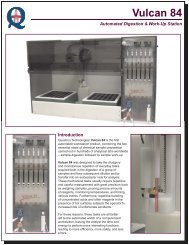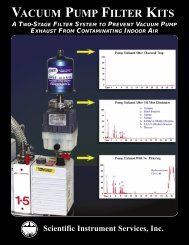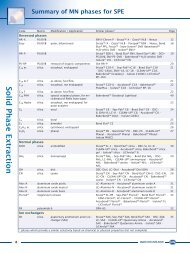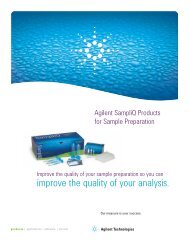Ascentis Express HPLC Columns with Fused-Core Technology ...
Ascentis Express HPLC Columns with Fused-Core Technology ...
Ascentis Express HPLC Columns with Fused-Core Technology ...
You also want an ePaper? Increase the reach of your titles
YUMPU automatically turns print PDFs into web optimized ePapers that Google loves.
Polar Compound Retention <strong>with</strong><br />
<strong>Ascentis</strong> <strong>Express</strong> HILIC<br />
Benefits of HILIC Separation<br />
Retention of highly polar analytes like metabolites<br />
Complimentary selectivity to reversed-phase<br />
chromatography<br />
Increased MS sensitivity<br />
Quick transfer from final steps of sample prep<br />
(SPE, protein precipitation, etc.)<br />
HILIC chromatography is gaining popularity due to<br />
increased retention of polar compounds. Many classes of<br />
polar compounds can be retained in HILIC. These include<br />
polar neutrals, polar acids, and polar and non-polar basic<br />
amines. Both polar and ionic interactions can contribute to<br />
retention and selectivity in this mode of chromatography.<br />
Figure 11. Comparison of the Analysis of Polar Molecules<br />
on <strong>Ascentis</strong> <strong>Express</strong> HILIC and <strong>Ascentis</strong> <strong>Express</strong> C18<br />
columns: <strong>Ascentis</strong> <strong>Express</strong> HILIC, 10 cm x 2.1 mm ID,<br />
2.7 μm particles (53939-U)<br />
<strong>Ascentis</strong> <strong>Express</strong> C18, 10 cm x 2.1 mm ID,<br />
2.7 μm particles (53823-U)<br />
mobile phase: 10:90; 100 mM ammonium formate, pH 3.0 <strong>with</strong><br />
concentrated formic acid:acetonitrile<br />
flow rate: 0.4 mL/min<br />
temp.: 35 °C<br />
det.: UV at 254 nm<br />
injection: 1 μL<br />
1. Acenaphthene, 80 μg/mL in mobile phase<br />
2. Adenosine, 35 μg/mL in mobile phase<br />
3. Cytosine, 75 μg/mL in mobile phase<br />
Acenaphthene<br />
How HILIC works<br />
HILIC separates compounds by using a mostly organic<br />
mobile phase across a polar stationary phase, causing<br />
solutes to elute in order of increasing polarity-the opposite<br />
of Reversed-Phase. Retention in HILIC is likely to be a<br />
combination of hydrophilic interaction, ion-exchange, and<br />
some reversed-phase retention. A typical mobile phase<br />
consists of 60-95% acetonitrile and an aqueous buffer.<br />
10-20 mM ammonium acetate or ammonium formate are<br />
useful due to volatility and solubility. The sample solvent<br />
should be similar in type and strength as the mobile phase.<br />
The sample solvent can contain a higher amount of organic<br />
than the mobile phase, but should not contain more water<br />
than the mobile phase.<br />
<strong>Ascentis</strong> <strong>Express</strong> HILIC<br />
2<br />
1<br />
3<br />
<strong>Ascentis</strong> <strong>Express</strong> C18<br />
2,3<br />
Adenosine<br />
G004182<br />
G003620<br />
G004183<br />
Shown in Figure 11 is a comparison of the analysis of<br />
highly polar molecules on <strong>Ascentis</strong> <strong>Express</strong> HILIC and<br />
<strong>Ascentis</strong> <strong>Express</strong> C18.<br />
Cytosine<br />
<strong>Ascentis</strong> <strong>Express</strong> HILIC Applications<br />
Amino acids<br />
Small, polar acids – (metabolomics)<br />
Biogenic amines – (neurotransmitters,<br />
contaminants in food &<br />
beverage)<br />
Phosphates – (pesticides, herbicides)<br />
Sugars<br />
Drug metabolites and conjugates<br />
G003033<br />
1<br />
0 1<br />
2 3 4<br />
5<br />
Min<br />
G004184<br />
technical service: 800-359-3041 (US and Canada only) / 814-359-3041<br />
9



